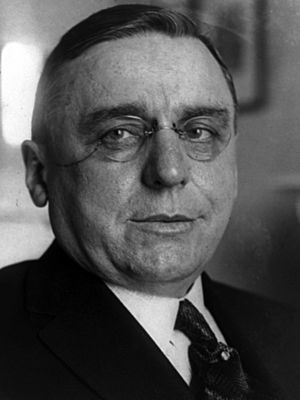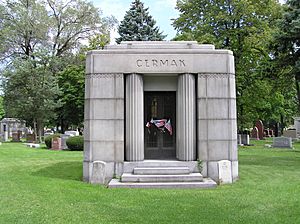Anton Cermak facts for kids
Quick facts for kids
Anton Cermak
|
|
|---|---|
 |
|
| Mayor of Chicago | |
| In office April 7, 1931 – March 6, 1933 |
|
| Preceded by | William Hale Thompson |
| Succeeded by | Frank J. Corr |
| President of the Cook County Board of Commissioners | |
| In office January 1923 – March 23, 1931 |
|
| Preceded by | Daniel Ryan Sr. |
| Succeeded by | Emmett Whealan |
| Chair of the Cook County Democratic Party | |
| In office 1928–1931 |
|
| Preceded by | George E. Brennan |
| Succeeded by | Patrick Nash |
| Member of the Chicago City Council from the 12th ward |
|
| In office 1919–1922 Serving with Joseph Novak, Joseph Cepak
|
|
| Preceded by | Otto Kerner Sr. |
| Succeeded by | ??? |
| In office 1909–1912 Serving with Michael Zimmer, William Schultz
|
|
| Preceded by | Joseph Uhlir |
| Succeeded by | Joseph Novak |
| Member of the Illinois House of Representatives | |
| In office 1902–1909 |
|
| Personal details | |
| Born |
Antonín Josef Čermák
May 9, 1873 Kladno, Bohemia, Austria-Hungary |
| Died | March 6, 1933 (aged 59) Miami, Florida, U.S. |
| Resting place | Bohemian National Cemetery |
| Political party | Democratic |
| Spouse |
Mary Horejs
(m. 1894–1928) |
| Children | 3 |
| Relatives | Otto Kerner Jr. (son-in-law) Richey V. Graham (son-in-law) Frank J. Jirka Jr. (grandson) |
Anton Joseph Cermak (born Antonín Josef Čermák; May 9, 1873 – March 6, 1933) was an American politician. He served as the 44th mayor of Chicago, Illinois. He was mayor from April 7, 1931, until his death on March 6, 1933. Cermak was shot by Giuseppe Zangara. Zangara was likely trying to shoot President Franklin D. Roosevelt. However, a bystander hit Zangara's arm, and Cermak was shot instead.
Contents
Life Story of Anton Cermak
Anton Joseph Cermak was born in Kladno, Austria-Hungary. This area is now part of the Czech Republic. His family worked in mining. In 1874, when he was a baby, he moved with his parents to the United States.
Early Life and Work
Cermak grew up in Braidwood, Illinois. He went to school there. As a teenager, he started working full-time. He followed his father into coal mining. He worked in mines in Will and Grundy counties.
At age 16, Cermak moved to Chicago. He worked with horses for the city's streetcar system. He also took evening classes to continue his education. He saved money and bought his own horse and cart. He started a business selling firewood. Later, he expanded it into a haulage business, which means moving goods.
Beginning in Politics
Cermak became more involved in politics. He worked in city government jobs. These included being a clerk for the police court and a bailiff for the city court. As he became more successful in politics, he also got involved in other businesses. He had interests in real estate, insurance, and banking.
He started his political journey as a local leader for the Democratic Party. In 1902, he was elected to the Illinois House of Representatives. Seven years later, he became an alderman for Chicago's 12th Ward. He served two terms in this role.
Cermak was elected President of the Cook County Board of Commissioners in 1922. This board manages Cook County, where Chicago is located. In 1928, he became the chairman of the Cook County Democratic Party. Then, in 1931, he was elected mayor of Chicago. In 1928, he also ran for the United States Senate. However, he lost that election.
Mayor of Chicago (1931–1933)
Cermak became mayor during a difficult time. The Great Depression had just begun. Many people in Chicago were unhappy with Prohibition, which made alcohol illegal. There was also a lot of violence from organized crime groups. A famous event was the St. Valentine's Day Massacre.
Connecting with Immigrants
Many different groups of immigrants had moved to Chicago. These included Czechs, Poles, Ukrainians, Jews, Italians, and African Americans. These groups often felt left out of the political system. Cermak was an immigrant himself. He understood that these new groups had a lot of voters. He saw them as a chance to build a strong political base for his party.
Before Cermak, the Democratic Party in Cook County was mostly led by Irish Americans. Cermak worked to bring together different ethnic groups. He even convinced William L. Dawson, a black politician, to join the Democratic Party. Dawson later became a powerful U.S. Representative. Cermak's skills helped create a very strong political group. With support from Franklin D. Roosevelt, Cermak helped bring Chicago's growing black community into the Democratic Party.
The Mayoral Election
In the 1931 mayoral election, Cermak ran against the current mayor, William “Big Bill” Hale Thompson. Thompson represented the older, Irish-led power structure in Chicago. Thompson tried to make fun of Cermak's immigrant background and his past as a pushcart worker. He said things like:
- I won’t take a back seat to that Bohunk, Chairmock, Chermack, or whatever his name is.
- Tony, Tony, where’s your pushcart at?
- Can you picture a World’s Fair mayor with a name like that?
Cermak famously replied, “He doesn’t like my name… it’s true I didn’t come over on the Mayflower, but I came over as soon as I could.” This message connected with many people from immigrant families in Chicago. Thompson's insults actually made him less popular.
Thompson was seen by many as not serious. Voters were also tired of the corruption in his government. His failure to control organized crime was another big issue. These reasons helped Cermak win the election with 58% of the votes on April 6, 1931. Cermak's win ended Thompson's political career. It also greatly reduced the Republican Party's power in Chicago. Since 1931, all mayors of Chicago have been Democrats.
Challenges as Mayor
During most of his time as mayor, Cermak faced a major problem: a "tax strike." From 1931 to 1933, a group called the Association of Real Estate Taxpayers encouraged people not to pay their property taxes. This group had over 30,000 members. They successfully slowed down tax collection. This made it hard for the city to pay teachers and keep services running. Cermak had to meet with President-elect Roosevelt to ask for money to fund important city services.
In a 1993 survey, historians and experts ranked Cermak as the twenty-fifth-best American big-city mayor between 1820 and 1993.
Death of Anton Cermak

On February 15, 1933, Anton Cermak was in Miami, Florida. He was shaking hands with President-elect Franklin D. Roosevelt at Bayfront Park. Suddenly, Giuseppe Zangara shot him. Zangara was trying to assassinate Roosevelt. At that moment, a woman named Lillian Cross hit Zangara's arm with her purse. This made his aim go off. Besides Cermak, Zangara also hit four other people. Their injuries were minor.
After being taken to the hospital, Cermak reportedly said to Roosevelt, “I’m glad it was me, not you.” This line is carved on his tomb. However, many historians are not sure if he actually said it.
Zangara told the police he hated rich and powerful people. He said he did not hate Roosevelt personally. Later, rumors spread that Cermak, not Roosevelt, was the real target. Some thought Cermak's promise to fight crime in Chicago was a threat to powerful crime groups. However, Roosevelt's biographer says there is no proof for this idea. Other authors have suggested different reasons for the shooting.
Cermak died at Jackson Memorial Hospital in Miami on March 6. His death was partly due to his wounds. Some people at the time and later wondered if the bullet wound was the direct cause of his death.
Zangara was found guilty of murder after Cermak died. He was executed in Florida's electric chair on March 20, 1933.
Cermak was buried in a special tomb at the Bohemian National Cemetery in Chicago. After his death, there was a struggle to decide who would lead his political party and become the next mayor.
A plaque honoring Cermak is still at the place where he was shot in Miami’s Bayfront Park. It has his famous words inscribed on it: “I’m glad it was me instead of you.” After Cermak's death, 22nd Street in Chicago was renamed Cermak Road. This street runs through areas with many Czech people. In 1943, a Liberty ship (a type of cargo ship) was named the SS A. J. Cermak in his honor.
Cermak's Family
Cermak's son-in-law, Otto Kerner Jr., became the 33rd Governor of Illinois. He also served as a federal judge.
His grandson, Frank J. Jirka, Jr., was with him in Miami when he was shot. Jirka later became an officer in the United States Navy. He was recognized for his bravery during the Battle of Iwo Jima in World War II. He was injured and lost both legs below the knee. After the war, he became a physician. In 1983, he was elected president of the American Medical Association. Cermak’s great niece, Kajon Cermak, is a radio broadcaster. His daughter, Lillian, was married to Richey V. Graham, who served in the Illinois General Assembly.
See also
- List of assassinated American politicians
Images for kids


